Mountain lion killed in oceanside
In a tragic turn of events, a mountain lion was struck and killed by a vehicle mere days after sightings of the majestic creature in downtown areas. The incident underscores the challenges of wildlife coexisting with urban landscapes and serves as a reminder of the importance of conservation efforts and responsible human behavior.
The mountain lion, known for its elusive nature and solitary habits, had been spotted roaming in downtown areas, sparking both awe and concern among residents. Sightings of large predators in urban environments often stir a mix of excitement and anxiety, highlighting the delicate balance between preserving natural habitats and accommodating human expansion.
While efforts were made to monitor the lion’s movements and ensure public safety, the unfortunate collision with a vehicle proved fatal for the animal. The incident serves as a somber reminder of the hazards faced by wildlife as they navigate increasingly fragmented landscapes intersected by roads and highways.
Mountain lions, also known as cougars or pumas, play a crucial role in maintaining ecosystem health by regulating prey populations and promoting biodiversity. However, as human populations expand and habitats shrink, interactions between humans and wildlife become more frequent, leading to conflicts and sometimes tragic outcomes.
In urban areas, encounters between humans and large predators like mountain lions pose unique challenges. While these animals typically avoid human contact, factors such as habitat loss, scarcity of prey, and curiosity can bring them into closer proximity to populated areas. Efforts to mitigate these conflicts often involve a combination of education, habitat preservation, and proactive management strategies.
One approach to reducing conflicts involves implementing measures to minimize attractants and create wildlife corridors that allow animals to move safely between habitats. This includes securing trash bins, keeping pets indoors or supervised, and advocating for wildlife-friendly infrastructure such as wildlife crossings and fencing.
Additionally, public awareness campaigns can help foster understanding and appreciation for native wildlife while promoting responsible behavior. Encouraging practices such as keeping a safe distance from wild animals, refraining from feeding them, and reporting sightings to authorities can help prevent potentially dangerous encounters.
In the wake of this unfortunate incident, there is an opportunity for reflection and action. It serves as a poignant reminder of the need for continued efforts to conserve natural habitats, mitigate human-wildlife conflicts, and foster coexistence between humans and the diverse array of species that share our planet.
As communities grapple with the complexities of urbanization and conservation, it is essential to prioritize the protection of wildlife and the preservation of their habitats. Through collaborative efforts and a commitment to responsible stewardship, we can strive towards a future where humans and wildlife can thrive side by side in harmony.
